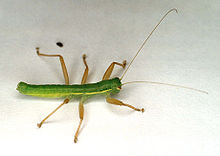Notoptera
| Notoptera Temporal range: Triassic - Recent
| |
|---|---|

| |
| Mantophasma zephyra | |
| Scientific classification | |
| Domain: | Eukaryota |
| Kingdom: | Animalia |
| Phylum: | Arthropoda |
| Class: | Insecta |
| Cohort: | Polyneoptera |
| Superorder: | Notoptera Crampton, 1915 |
| Orders & families | |
Order Grylloblattodea
Order Mantophasmatodea
| |
| Synonyms | |
|
Xenonomia Terry & Whiting, 2005 | |
The wingless insect
History of research
The name was originally coined in 1915 for a group of fossil orthopteroids, and largely forgotten until it was resurrected and redefined ("Notoptera Crampton sensu novum") by Engel and Grimaldi in 2004 (after the discovery of living Mantophasmatidae), who recommended to give a single order that includes both the living and fossil representatives of the lineage.[1]
Terry and Whiting in 2005 independently proposed a new name, "Xenonomia", for the same lineage of
In 2006, Cameron, Barker, and Whiting studied the
In 2008, Damgaard and colleagues examined the mitochondrial genome of 8 described and 4 undescribed austrophasmatine species, and some mantophasmatines; the major clades were confirmed.[5]
In 2012, Predel and colleagues studied the peptidomics of 71 populations of Mantophasmatodea, confirming that austrophasmatines are a monophyletic lineage, and noting that the development of the capa-neurons of the ventral nervous system implies a close relationship with the Grylloblattodea.[6]
Gallery
-
A nymph of a mantophasmatid
-
Grylloblattid
See also
Further reading
- Ando H. 1982. Biology of the Notoptera. Kashiyo-Insatsu Co. Ltd., Nagano, Japan.



